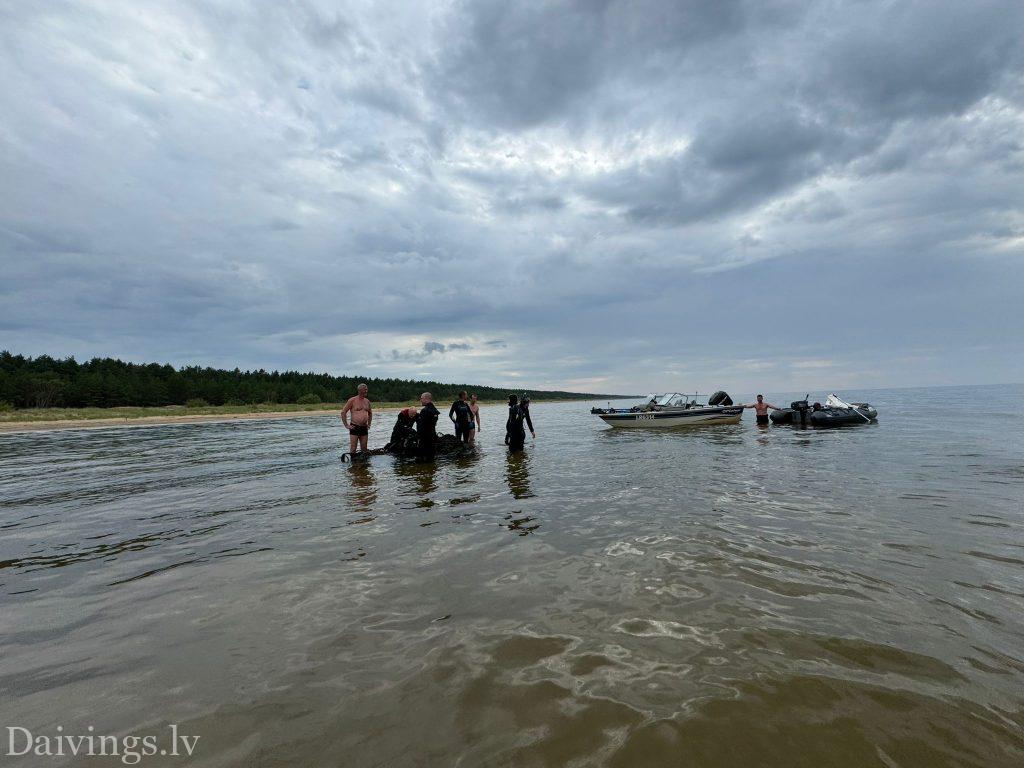On Tuesday, July 24, 2024, the underwater diving club "Diving” representative Valters Preimanis informed LETA that divers have pulled an old fisherman's net weighing about three tons from the sea.

The Baltic Sea, although seemingly small, hides many secrets and dangers. One such threat is 'ghost nets' - abandoned fishing gear that continues to 'fish' long after it has been lost or left on the seabed. These nets become deadly traps for marine life and also pollute the environment with microplastics. Latvian divers are committed to fight this problem and help clean the Baltic Sea of these "ghosts".
These so-called "ghost nets" are a serious threat to the Baltic Sea ecosystem.
Thousands of abandoned and lost fishing gear drift in the dark waters of the Baltic Sea, continuing to catch and kill marine animals and pollute the sea with microplastics. This year, for the first time, such nets were removed from Latvian coastal waters.
Five lifting buoys were used to raise the net, and the approximately three-tonne net was hoisted out with metal anchors. The abandoned net posed a safety hazard to navigation and continued to catch fish that died after becoming entangled in it.
This event was carried out voluntarily and in free time. In cooperation with "Carnikavas Komunalservis", the net was brought ashore to be dried and disposed of.

The members of the diving club "DAIVINGS.LV" (diving club for PADI courses) participated in this promotion. Their experience and knowledge of the Kurzeme coast and weather are invaluable. This time they didn't visit an old shipwreck for fun, but to highlight abandoned fishing nets that threaten the marine environment.

Diver Guntis Zilberts from the club "DAIVINGS.LV" explained that many well-preserved objects are covered with nets, so it is impossible to fully explore them and understand what is there. That's why they dive.
Preparations began several days in advance. Diving equipment was checked and inventory prepared. Security is a top priority, as mining networks is complex and dangerous. This can only be done by technical divers with special knowledge and training.
Guntis Zilberts explained that a diver must be able to perform this task and feel comfortable underwater. In addition, it is important to dive in pairs because of the risk of entanglement in netting or other equipment that the diver may not notice. In such a situation, a partner can help you break free. Therefore, during their daily dives, they try not to approach the nets unless necessary.
The divers scouted this particular location in advance to assess the situation and plan their work. The wreck of the sunken ship, around which ghost nets are entangled, is located four and a half kilometers from the port of Carnikava. It was found several years ago.
To reach the nets, divers must dive to a depth of 20 meters. It is a team effort involving at least three people: two dive and one stays in the boat. This is the first time they will bring up ghost nets from the depths.
Martin Anger explained that a plan is always developed before diving, where depth, time spent underwater, ascent time and other important aspects are discussed. The person in the boat knows what is happening underwater, and the diving partners communicate with special hand signs. The time spent underwater depends on the depth. At a depth of 40 meters it is 30 minutes.
The head of the World Wildlife Fund comments
Magda Jentgen is a marine environment expert for the World Wide Fund for Nature (WWF). Diving has been her hobby for many years, which helps her in her work. As Magda says, looking at the map, the Baltic Sea may seem relatively small on a global scale, but when you dive into the sea, it is not easy to find something.
"Lost and abandoned fishing nets, or 'ghost nets', are a global problem that also affects the Baltic Sea. Experts have estimated that around 10,000 pieces of ghost nets are lost in the Baltic Sea every year. These nets are dangerous for several reasons - even when they are abandoned, they continue to 'fish' and special species such as Baltic porpoise, seals and cod die in them.
Also, they are also made of plastic and over time cause microplastic pollution in the sea. We are especially happy for the divers who, on July 23, pulled out a large-scale net from the Gulf of Riga on their own. It will only have a positive impact on the wealth of our nation - the Baltic Sea."
–Magda Jentgen, Head of the Baltic Sea and Freshwater Program of the WWF

The brave action of the divers of the Latvian "DAIVINGS.LV" club, lifting an abandoned fishing net from the Baltic Sea, is an inspiring example of how everyone can contribute to the protection of the environment. This initiative not only helped save marine animals but also raised awareness about the problem of 'ghost nets' and its impact on the marine ecosystem. Although the Baltic Sea seems small, its cleanliness and health is the responsibility of all of us.
Invitation to readers: Let's remember that each of us can contribute to the protection of the environment. Even small actions like sorting trash or participating in beach cleanups can make a big difference. Together we can keep the Baltic Sea clean and healthy for future generations.

